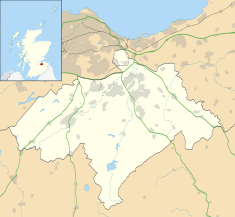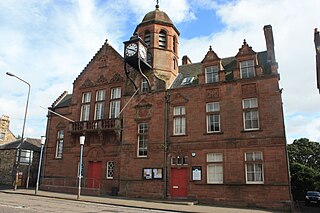
Penicuik is a town and former burgh in Midlothian, Scotland, lying on the west bank of the River North Esk. It lies on the A701 midway between Edinburgh and Peebles, east of the Pentland Hills.
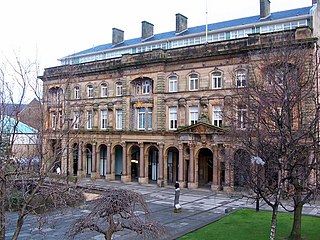
Greenock Municipal Buildings is a municipal structure in Clyde Square, Greenock, Scotland. The municipal buildings, which are the headquarters of Inverclyde Council, are Category A listed.

Musselburgh Tolbooth is a municipal building in the High Street in Musselburgh, East Lothian, Scotland. The tolbooth, which was the headquarters of Musselburgh Burgh Council, is a Category A listed building. At right angles and attached to it is the Musselburgh Town House.

Barrhead Burgh Hall, also known as Barrhead Burgh Court Hall and Burgh Chambers and as the James McGuire Building, is a municipal complex in Main Street, Barrhead, East Renfrewshire, Scotland. The complex was the headquarters of Barrhead Burgh Council. It consists of two distinct buildings separated by an iron gate: Barrhead Burgh Court Hall, which is a Category C listed building, and, Barrhead Burgh Chambers, which is also a Category C listed building, although, as a group, they are listed at Category B.

Prestwick Burgh Hall, also known as Prestwick Freeman's Hall and Prestwick Freemen's Hall, is a municipal building in Kirk Street, Prestwick, Scotland. The structure, which served as the meeting place of Prestwick Burgh Council, is a Category B listed building.

The Municipal Buildings are based in Buccleuch Street in Dalkeith, Scotland. The structure, which served as the meeting place of Dalkeith Burgh Council, is a Category B listed building.

Saltcoats Town Hall is a municipal building in Countess Street, Saltcoats, North Ayrshire, Scotland. The building, which is used by North Ayrshire Council as hub for the delivery of local services, is a Category B listed building.
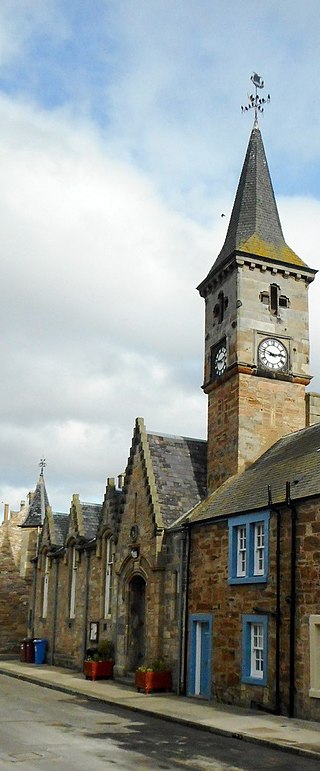
Elie and Earlsferry Town Hall is a former municipal structure in High Street in Elie and Earlsferry, Scotland. The structure, which is currently used as an events venue, is Category B listed.

Kinross Town Hall forms part of a complex of municipal buildings in the High Street, Kinross, Perth and Kinross, Scotland. The town hall, which has been converted for residential use, is a Category B listed building.

Dumbarton Municipal Buildings is a structure in Glasgow Road, Dumbarton, West Dunbartonshire, Scotland. The structure, which is used as a venue for weddings and civil partnership ceremonies, is a Category B listed building.

Falkland Town Hall is a municipal building in the High Street, Falkland, Fife, Scotland. The structure, which has been converted for use as offices and as shops, is a Category A listed building.
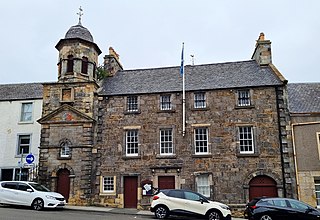
Inverkeithing Town House is a municipal building in the Townhall Street, Inverkeithing, Fife, Scotland. The structure, which is used as a base by members of the local community council, is a Category A listed building.

Dysart Tolbooth and Town House is a municipal building in the High Street, Dysart, Fife, Scotland. The structure, which was comprehensively restored in 2009, is a Category A listed building.

Pittenweem Parish Church and Tolbooth Steeple is an ecclesiastical and municipal complex in the High Street, Pittenweem, Fife, Scotland. The structure, which is used as the local parish church, is a Category A listed building.
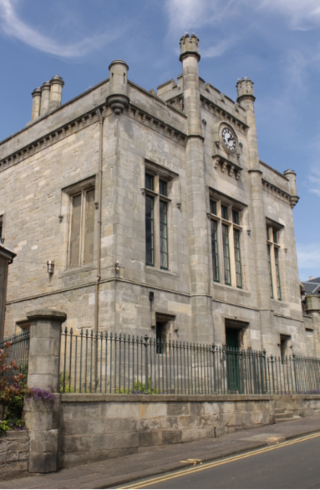
Kinghorn Town Hall is a municipal building in St Leonard's Place, Kinghorn, Fife, Scotland. The structure, which is used as holiday accommodation for tourists, is a Category B listed building.

Newburgh Town House is a municipal building in the High Street in Newburgh, Fife, Scotland. The structure, which is used as a series of artists' studios, is a Category B listed building.

Dreel Halls is a municipal complex in Elizabeth Place, Anstruther Wester, Fife, Scotland. The complex, which is used as a community events venue, consists of the former St Nicholas's Parish Church, which is a Category A listed building, and the former Anstruther Wester Town Hall, which is a Category C listed building.

Burntisland Burgh Chambers is a municipal structure in the High Street, Burntisland, Fife, Scotland. The building, which is the meeting place of the Burntisland Community Council, is a Category B listed building.

Kirkwall Town Hall is a municipal building in Broad Street, Kirkwall, Orkney, Scotland. The structure, which is currently used as a community events venue, is a Category B listed building.

Coldstream Town Hall is a municipal building in the High Street, Coldstream, Scottish Borders, Scotland. The structure, which currently accommodates a library and a registration office, is a Category B listed building.

